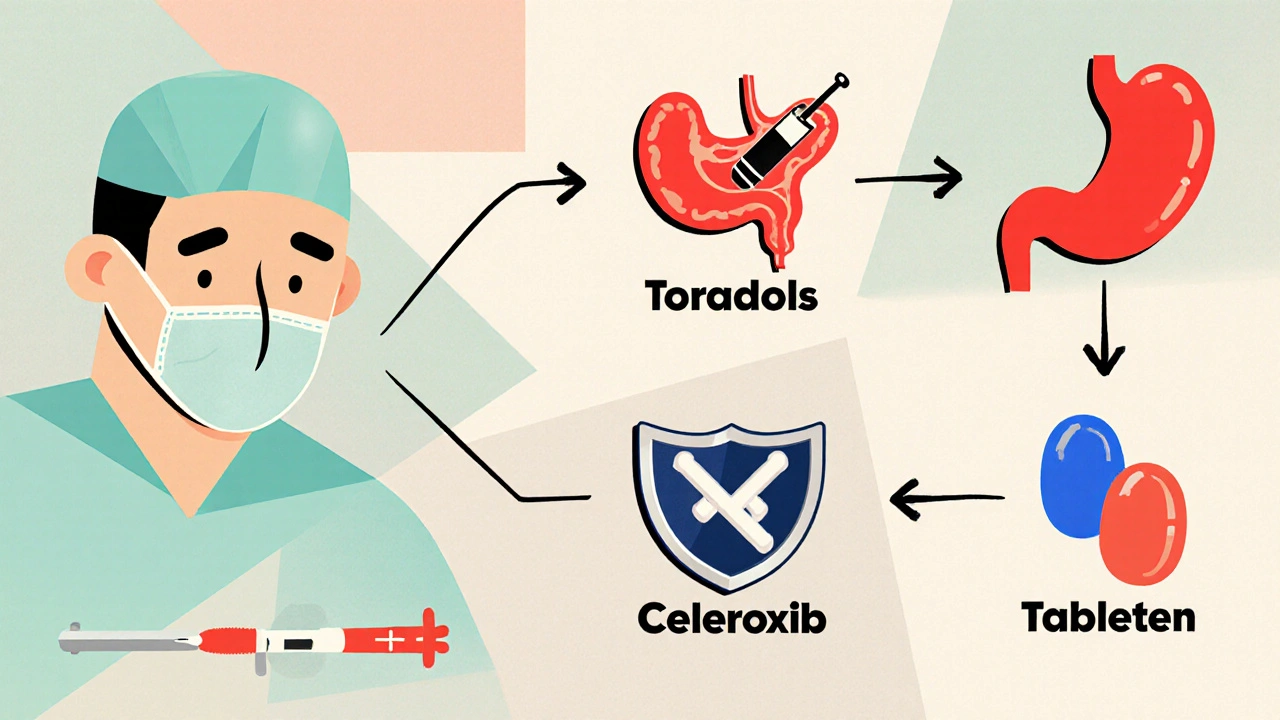Pain Medication Decision Tool
Choose Your Pain Situation
Recommended Medication
When you need fast, strong pain relief, doctors often turn to Toradol. But it’s not the only option, and each alternative brings its own mix of strengths and downsides. This guide breaks down how Toradol (ketorolac) stacks up against the most common NSAIDs and a few non‑NSAID choices, so you can see which drug fits your situation best.
What is Toradol (Ketorolac)?
Ketorolac is a potent non‑steroidal anti‑inflammatory drug (NSAID) that works by blocking the cyclooxygenase (COX) enzymes responsible for producing prostaglandins, the chemicals that cause pain, fever, and inflammation. It was first approved by the FDA in 1990 and is marketed under the brand name Toradol for injectable and oral formulations.
How Ketorolac Works: The COX Connection
Ketorolac inhibits both COX‑1 and COX‑2 enzymes, reducing prostaglandin synthesis throughout the body. This dual inhibition gives it strong analgesic power, often comparable to that of moderate‑strength opioids, but without the risk of respiratory depression or dependence. However, the same COX‑1 blockade can affect protective stomach lining and kidney function, which is why usage is limited to short courses.
Typical Dosage and Safety Limits
- Intravenous or intramuscular: 30 mg every 6 hours (max 120 mg/24 h).
- Oral tablets: 10 mg every 4-6 hours (max 40 mg/24 h).
- Maximum duration: 5 days for adults, even shorter for the elderly or those with renal impairment.
Because of its potency, ketorolac is contraindicated in patients with active peptic ulcer disease, severe heart failure, or significant kidney disease. It also interacts with anticoagulants, increasing bleed risk.
Key Advantages of Toradol
- Rapid onset: Pain relief often begins within 30 minutes of IV administration.
- High efficacy: Comparable to low‑dose morphine for postoperative pain.
- Opioid‑sparing: Can reduce the amount of opioid needed after surgery.
Common Alternatives to Ketorolac
Below is a quick snapshot of the most frequently prescribed NSAIDs and a couple of non‑NSAID options that people consider as substitutes.
- Ibuprofen - Over‑the‑counter (OTC) NSAID, COX‑1/2 inhibitor, milder pain control, widely used for musculoskeletal pain.
- Naproxen - OTC or prescription, longer half‑life, good for chronic inflammatory conditions.
- Diclofenac - Prescription NSAID, strong anti‑inflammatory effect, available as gel for topical use.
- Celecoxib - Selective COX‑2 inhibitor, lower gastrointestinal risk, often used when ulcer risk is high.
- Acetaminophen (Paracetamol) - Analgesic/antipyretic, no anti‑inflammatory action, safe for most patients at therapeutic doses.
- Aspirin - Older NSAID, antiplatelet effect, used for cardiovascular protection as well as pain.
- Opioids (e.g., morphine, oxycodone) - Strong analgesia, high risk of dependence, usually reserved for severe acute pain.
Side‑Effect Profiles: How the Drugs Differ
All NSAIDs share a core set of adverse effects, primarily gastrointestinal (GI) irritation, platelet dysfunction, and renal impact. However, the degree varies widely.
| Drug | Typical Strength | GI Risk | Renal Risk | Duration of Use | OTC Availability |
|---|---|---|---|---|---|
| Ketorolac (Toradol) | 10‑30 mg | High (COX‑1 inhibition) | Moderate‑high, especially >48 h | ≤5 days | No |
| Ibuprofen | 200‑400 mg | Moderate | Low‑moderate | Up to 10 days OTC, longer prescription | Yes |
| Naproxen | 220‑500 mg | Moderate | Low‑moderate | 10 days OTC, longer prescription | Yes |
| Diclofenac | 50‑75 mg | High (especially oral) | Moderate | 15‑30 days prescription | No |
| Celecoxib | 100‑200 mg | Low (COX‑2 selective) | Low‑moderate | 30 days prescription | No |
| Acetaminophen | 325‑1000 mg | Very low | Low (unless >4 g/day) | Any duration | Yes |
When to Choose Toradol Over the Rest
Toradol shines in short‑term, high‑intensity pain scenarios where you need rapid relief and want to avoid opioids. Typical use cases include:
- Post‑operative pain after orthopedic or abdominal surgery.
- Severe acute musculoskeletal injuries (e.g., fractures, dislocations).
- Pain that’s not controlled by standard OTC NSAIDs.
Because of its renal and GI profile, it’s not ideal for:
- Elderly patients with chronic kidney disease.
- People with a history of peptic ulcers or GI bleeding.
- Long‑term chronic pain management; here drugs like naproxen or celecoxib are safer for extended use.
Cost and Accessibility Considerations
Toradol is a prescription‑only medication and generally costs more per dose than OTC options. In Australia, a typical 30 mg injection can run around AUD 30‑40, while a month’s supply of ibuprofen tablets may be under AUD 5. However, the hospital setting often covers the drug for surgical patients, making cost less of a barrier in that context.

Practical Decision Tree
- Is the pain acute and severe (post‑surgery, major injury)? - Yes → Consider Toradol for ≤5 days.
- If not severe or needs longer than 5 days, choose an OTC NSAID like ibuprofen or naproxen.
- If the patient has high GI risk, prefer celecoxib (COX‑2 selective) or acetaminophen.
- For chronic inflammatory diseases (e.g., rheumatoid arthritis), diclofenac or naproxen are common long‑term options.
- When opioid use is a concern, use Toradol as an opioid‑sparing bridge before tapering to weaker analgesics.
Monitoring and Follow‑Up
Anyone on ketorolac should have renal function checked before starting and be monitored for signs of GI bleeding (dark stools, abdominal pain). If any adverse sign appears, discontinue immediately and switch to a safer alternative.
Frequently Asked Questions
Can I take Toradol with ibuprofen?
No. Mixing two NSAIDs increases the risk of stomach bleeding and kidney damage without adding extra pain relief. Choose one or the other, and keep the total dose within recommended limits.
Is Toradol safe for pregnant women?
Ketorolac is classified as Pregnancy Category C in the US and is generally avoided, especially in the third trimester, because it may affect fetal kidney function and prolong labor.
How does celecoxib compare to ketorolac for postoperative pain?
Celecoxib offers a milder pain relief but has a lower GI risk. It’s useful when a patient can’t tolerate a short, high‑potency NSAID. However, it may not match ketorolac’s rapid, opioid‑level effect.
What is the maximum safe dose of ketorolac for adults?
For IV or IM use, the ceiling is 120 mg per 24 hours; for oral use, it’s 40 mg per 24 hours. Never exceed a 5‑day total treatment period.
Can I use acetaminophen together with ketorolac?
Yes, because they work via different pathways. Adding acetaminophen can improve pain control while allowing a lower ketorolac dose, potentially reducing side‑effects.
Bottom Line
If you need aggressive, short‑term pain relief and your doctor can monitor you, Toradol is a powerful tool that can keep you off opioids. For everyday aches, longer‑term conditions, or patients with GI or kidney concerns, the safer, often cheaper alternatives like ibuprofen, naproxen, or celecoxib are usually the smarter choice.

Comments
Octavia Clahar October 25, 2025 at 20:19
Toradol really shines when you need that quick knock‑out of pain after a big surgery.
It’s like the superhero of NSAIDs, swooping in with a 30‑minute onset.
But the price you pay is the hidden gut‑and‑kidney drama that many of us overlook.
When you think about the COX‑1 blockade, imagine a fragile curtain shielding your stomach; Toradol tears it down.
That’s why the five‑day limit feels like a cruel sentence for patients who are already suffering.
I’ve seen people swing back to opioids because they were scared of the bleeding risk.
The opioid‑sparing angle is a genuine gift, especially in the era of addiction awareness.
Yet the temptation to overprescribe lingers in every OR, like a whisper from an old habit.
A good clinician will balance the rapid relief with a vigilant eye on renal labs.
If you’re elderly or have a history of ulcers, the gamble becomes far less attractive.
In my experience, pairing a low dose of acetaminophen can let you cut the Toradol amount in half.
That combo often keeps the pain at bay while giving the stomach a breather.
Remember, the cheapest drug isn’t always the safest long‑term companion.
So weigh the urgency of the pain against the hidden costs to your body.
When you get it right, Toradol can be a lifesaver without dragging anyone back into the opioid abyss.
Cheyanne Moxley November 7, 2025 at 10:20
Honestly the guide pretends the kidney risk is just a tiny footnote and that’s just lazy.
Anyone with a ounce of sense knows you can’t keep flashing Toradol like a magic wand without watching those labs.
It’s like they’re sugar‑coating a wolf in a cute sweater and hoping we don’t notice.
Kevin Stratton November 20, 2025 at 03:53
It’s a curious paradox how we chase swift relief yet sidestep the silent toll on our organs.
One might say Toradol is the philosopher’s stone of pain, turning agony into comfort at a hidden alchemical price. :)
In the grand tapestry of medicine, each thread-be it NSAID or acetaminophen-contributes to the pattern of recovery.
Megan Dicochea December 2, 2025 at 21:26
Respectfully I think the article nails the key points but could use a bit more on monitoring.
Renal labs are a must especially if you’re on the higher end of dosing.